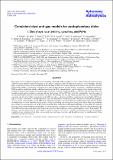Consistent dust and gas models for protoplanetary disks I. Disk shape, dust settling, opacities, and PAHs
Abstract
We propose a set of standard assumptions for the modelling of Class II and III protoplanetary disks, which includes detailed continuum radiative transfer, thermo-chemical modelling of gas and ice, and line radiative transfer from optical to cm wavelengths. The first paper of this series focuses on the assumptions about the shape of the disk, the dust opacities, dust settling, and polycyclic aromatic hydrocarbons (PAHs). In particular, we propose new standard dust opacities for disk models, we present a simplified treatment of PAHs in radiative equilibrium which is sufficient to reproduce the PAH emission features, and we suggest using a simple yet physically justified treatment of dust settling. We roughly adjust parameters to obtain a model that predicts continuum and line observations that resemble typical multi-wavelength continuum and line observations of Class II T Tauri stars. We systematically study the impact of each model parameter (disk mass, disk extension and shape, dust settling, dust size and opacity, gas/dust ratio, etc.) on all mainstream continuum and line observables, in particular on the SED, mm-slope, continuum visibilities, and emission lines including [OI] 63 μm, high-J CO lines, (sub-)mm CO isotopologue lines, and CO fundamental ro-vibrational lines. We find that evolved dust properties, i.e. large grains, often needed to fit the SED, have important consequences for disk chemistry and heating/cooling balance, leading to stronger near- to far-IR emission lines in general. Strong dust settling and missing disk flaring have similar effects on continuum observations, but opposite effects on far-IR gas emission lines. PAH molecules can efficiently shield the gas from stellar UV radiation because of their strong absorption and negligible scattering opacities in comparison to evolved dust. The observable millimetre-slope of the SED can become significantly more gentle in the case of cold disk midplanes, which we find regularly in our T Tauri models. We propose to use line observations of robust chemical tracers of the gas, such as O, CO, and H2, as additional constraints to determine a number of key properties of the disks, such as disk shape and mass, opacities, and the dust/gas ratio, by simultaneously fitting continuum and line observations.
Citation
Woitke , P , Min , M , Pinte , C , Thi , W -F , Kamp , I , Rab , C , Anthonioz , F , Antonellini , S , Baldovin-Saavedra , C , Carmona , A , Dominik , C , Dionatos , O , Greaves , J S , Güdel , M , Ilee , J D , Liebhart , A , Ménard , F , Rigon , L , Waters , L B F M , Aresu , G , Meijerink , R & Spaans , M 2016 , ' Consistent dust and gas models for protoplanetary disks I. Disk shape, dust settling, opacities, and PAHs ' , Astronomy & Astrophysics , vol. 586 , pp. A103 . https://doi.org/10.1051/0004-6361/201526538
Publication
Astronomy & Astrophysics
Status
Peer reviewed
ISSN
0004-6361Type
Journal article
Collections
Items in the St Andrews Research Repository are protected by copyright, with all rights reserved, unless otherwise indicated.

